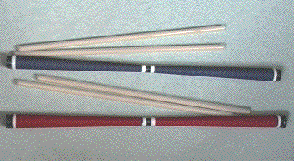Devil Sticks
Devil sticks are an ancient chinese folk toy. Player uses two handsticks to control a third, larger center stick. Recommended for ages ten and up.

The Devil Stick Book has enough information to keep both beginners and advanced stickers interested. 107 pages, $9.95.
All possible uses of the devil stick are mentioned: balancing, using only one handstick or two centre sticks, partner work and advanced trucks such as propellers and curls. Kaskade
The well-documented history of the devil stick is fascinating. Toby Ayer, Juggler's World
Traveling through Europe with only two books in my backpack: Mr. Strong's book and Fodor's Budget Europe. I learned some new devil stick tricks and didn't get lost. Susie Williams, Two Ply Press

Variations with a set of devil sticks
corkscrew closeup
Open Bicycle with Quad Touches
Body Moves
- Body Rolls
- Albatross
- Back Rolls
- Pinwheels
- Gravy
- Flying Clipper
Moves Around the Head
- Bowtie
- Necklace
- Guillotine
- Headspin
Review (by Toby Ayer) originally appeared in the Spring 1992 issue of Juggler's World magazine. Reprinted with permission of the author and publisher.
The Devil Stick Book
By Todd Strong. Brian Dube, New York, 1990. 107 pages. $9.95 soft cover.
Todd Strong, former IJA board member and teacher at the French National Circus School, teaches in his book the methods of learning the devil stick. It is a comprehensive work, covering basic technique, tricks, other skills and the history of the prop.
Strong's book is divided into seven chapters. After offering some good thoughts on learning skills, breathing and practicing, he introduces terminology, then presents his first section gently and slowly. He describes gripping the sticks, trapping and "normal, regular devil sticking." He continues with beginning variations, important factors for proper sticking technique, and more consideration of how to practice.
The next section, more than a third of the book, shows the breadth of possible tricks. Strong explains both simple moves and very advanced ones, including single sticking, crossed arms, dual center sticks and "chopsticks" variations with up to three center sticks.
A brief and valuable chapter on balancing follows, and then another on games and partner possibilities. Strong's ideas for team tricks are based on those from juggling and diabolo moves, and, as he points out, most are seldom seen with devil sticks.
The well-documented history of the devil stick is fascinating. It speculates on the origins of the prop, covers its "discovery" by Europeans in China, and reveals the etymology of its name. The book's last chapter encourages exploration and experimentation with the devil stick, emphasizing the plethora of possibilities.
The Devil Stick Book is easy reading, and it is illustrated well with simple, accurate drawings. The explanations are easy to understand and the tips helpful.
The laid-back format of the book works well. Using aikido sayings and analogies to other objects to describe tricks, Strong conveys successfully the joy he takes in playing with the devil sticks, and that which the reader could experience as well.
The following review originally appeared in the June 1991 issue of Kaskade, the European Juggling Magazine. Reprinted with permission of the publisher.
The Devil Stick Book
Published by Butterfingers and Brian Dube. ISBN 0951324012 or ISBN 0951699806. German edition published by edition aragon, Devil Stick, ISBN 392469060X, DM 16,80
Here is another book dealing with a special aspect of juggling. Any regular conventioneer may have noticed that relatively few jugglers try their hand at devil-sticking, and only a very few are true masters of the art. Perhaps what has been missing so far is a word of encouragement and some qualified instruction. As Todd Strong writes, playing with the devil stick does not always lead to quick success. However, his encouragement consists not only in a heartening "keep at it" rhetoric, but gives very detailed descriptions of each step and the difficulties which learners may encounter on the way to getting this devilish thing to dance. Incidentally, the name did not originate from hell at all - but perhaps you'd better let Todd explain that one himself in one of the book's "theoretical" chapters.
Of course, the book is not confined to beginners' moves. All possible uses of the devil stick are mentioned: balancing, using only one handstick or two centre sticks, partner work and advanced tricks such as propellers and curls. Each trick is accompanied by an illustration for further clarity.
Todd also stresse the potential for stretching your creative powers with the devil stick by inventing new tricks and combinations. A German edition of this book will be appearing in November, 1991 under the simple title: "Devil Stick".

- Home
- About
- Ball Juggling
- Cigar Boxes
- Club Juggling
- Club Swinging
- Comedy Writing
- Cup Stacking
- Devil Sticks
- Diabolo
- Diabolo Postcards
- Dice Stacking
- Hat Manipulation
- Lasso
- Miscellanous Juggling
- Parachute Games
- Poi Swinging
- Ring Juggling
- Shaker Cups
- Skill Games
- Staff
- Tennis Balls and Can
- New Games Foundation
- Ordering and Shipping
- Contact Information
- Peeps (photos of birds and stuff)
- Personal Thoughts
- Workshops
- Links
- Questions? Comments? Feedback?